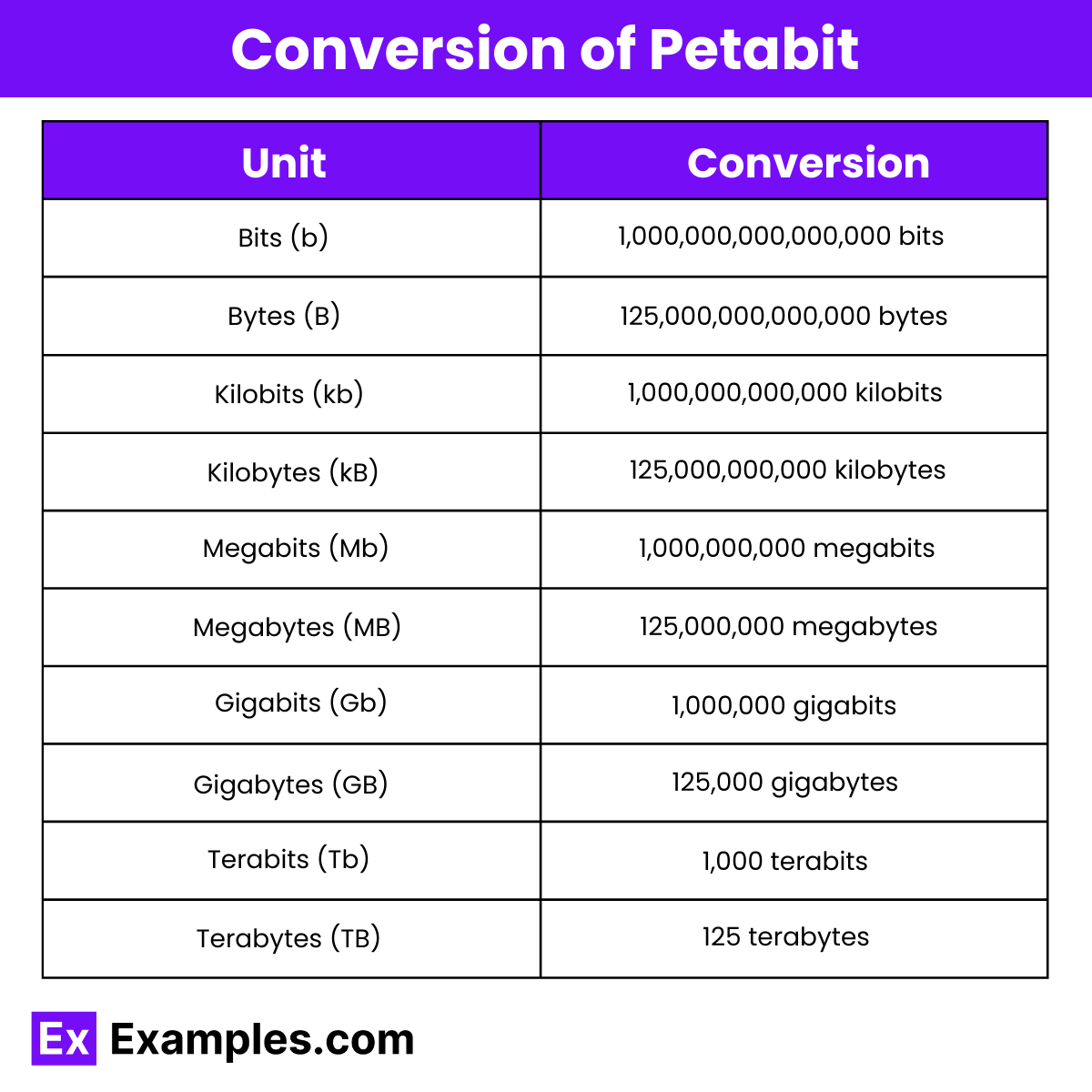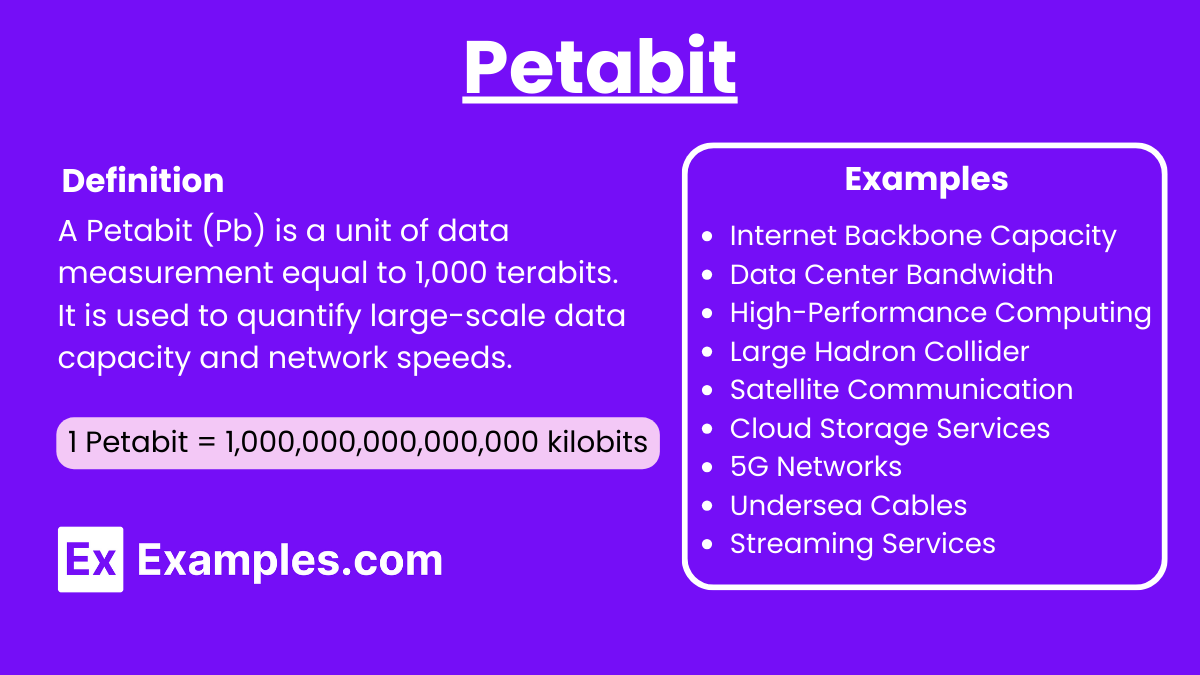Petabit – 20 Examples, Conversion Chart, Uses
A Petabit is a unit of digital information storage equivalent to one quadrillion bits or 1,000 terabits. In the realm of cloud computing, the massive capacity of petabits is essential for handling the vast amounts of data generated and stored daily. Digital communication networks, which rely on rapid data transfer, benefit immensely from petabit-level speeds. As communication technology advances, the need for petabit-scale infrastructure becomes increasingly critical to support growing data demands.
What is Petabit?
A petabit is a unit of digital information storage or transmission equal to 1,000 terabits. It is commonly used to measure large-scale data capacities and high-speed network bandwidths.
Examples of Petabit
- Internet Backbone Capacity: Petabit-level data rates can be seen in the infrastructure of global internet backbones.
- Data Center Bandwidth: Modern data centers often have petabit-scale bandwidth to handle massive amounts of data.
- High-Performance Computing: Supercomputers may process data at petabit speeds.
- Large Hadron Collider: Data generated by particle collisions can reach petabit scales.
- Satellite Communication: High-capacity satellites can transmit data at petabit rates.
- Cloud Storage Services: Providers like AWS, Google Cloud, and Azure manage petabits of data transfer daily.
- 5G Networks: Future iterations of 5G technology could handle petabit-level data transmission.
- Telecommunication Networks: Core networks of major telecom operators can support petabit data rates.
- Undersea Cables: Submarine communication cables connecting continents carry petabits of data.
- Streaming Services: Platforms like Netflix and YouTube may collectively stream petabits of video content.
- Financial Transactions: Global financial systems process petabit-scale data for transactions and analytics.
- Social Media Platforms: Networks like Facebook and Twitter handle petabits of data from user activity.
- IoT Networks: The Internet of Things ecosystem can generate petabits of data from connected devices.
- Genomic Research: Sequencing and analyzing genomes produce petabit-scale data.
- Remote Sensing: Satellite imaging and remote sensing technologies can generate petabits of data.
- Virtual Reality: High-definition VR and AR applications may use petabit data rates for seamless experiences.
- Autonomous Vehicles: Data from autonomous vehicles, including real-time navigation and sensor data, can reach petabit levels.
- Global Email Traffic: Worldwide email communication can accumulate petabits of data.
- Smart Cities: Integrated smart city infrastructures produce petabit-scale data from various sensors and systems.
- Digital Twins: Large-scale simulations and digital twin models can generate and process petabits of data.
Conversion of Petabit

| Unit (Symbol) | Equivalent Value |
|---|---|
| Bits (b) | 1 Petabit = 1,000,000,000,000,000 bits |
| Bytes (B) | 1 Petabit = 125,000,000,000,000 bytes |
| Kilobits (kb) | 1 Petabit = 1,000,000,000,000 kilobits |
| Kilobytes (kB) | 1 Petabit = 125,000,000,000 kilobytes |
| Megabits (Mb) | 1 Petabit = 1,000,000,000 megabits |
| Megabytes (MB) | 1 Petabit = 125,000,000 megabytes |
| Gigabits (Gb) | 1 Petabit = 1,000,000 gigabits |
| Gigabytes (GB) | 1 Petabit = 125,000 gigabytes |
| Terabits (Tb) | 1 Petabit = 1,000 terabits |
| Terabytes (TB) | 1 Petabit = 125 terabytes |
Petabit to Bits (b)
The smallest unit of digital information. One petabit equals 1,000,000,000,000,000 bits. This is often used to describe very large quantities of data.
Petabit to Bytes (B)
There are 8 bits in a byte. One petabit equals 125,000,000,000,000 bytes. Bytes are commonly used to measure file sizes and storage capacity.
Petabit to Kilobits (kb)
A kilobit is 1,000 bits. One petabit equals 1,000,000,000,000 kilobits. This unit is often used for measuring data transfer rates, such as internet speed.
Petabit to Kilobytes (kB)
A kilobyte is 1,000 bytes. One petabit equals 125,000,000,000 kilobytes. This unit is also used to describe file sizes, particularly smaller files.
Petabit to Megabits (Mb)
A megabit is 1,000,000 bits. One petabit equals 1,000,000,000 megabits. This unit is used for higher speed internet connections and data rates.
Petabit to Megabytes (MB)
A megabyte is 1,000,000 bytes. One petabit equals 125,000,000 megabytes. This unit is used for medium-sized files, like MP3 songs or digital photos.
Petabit to Gigabits (Gb)
A gigabit is 1,000,000,000 bits. One petabit equals 1,000,000 gigabits. Gigabits are used for even faster data transfer rates and large data quantities.
Petabit to Gigabytes (GB)
A gigabyte is 1,000,000,000 bytes. One petabit equals 125,000 gigabytes. This unit is used for larger files, such as HD videos and large software applications.
Petabit to Terabits (Tb)
A terabit is 1,000,000,000,000 bits. One petabit equals 1,000 terabits. This is a large unit used in telecommunications and data centers.
Petabit to Terabytes (TB)
A terabyte is 1,000,000,000,000 bytes. One petabit equals 125 terabytes. This unit is used for extremely large storage capacities, like those in data centers or for big data applications.
Importance of Petabit
High-Speed Data Transmission
1. Advancements in Technology: Petabit networks enable the rapid transmission of vast amounts of data, essential for the growth of technologies like 5G, virtual reality, and the Internet of Things (IoT).
- These advancements rely on high-speed and high-capacity data channels to function effectively.
2. Enhanced Connectivity: Faster data transfer rates provided by petabit technology ensure smooth and uninterrupted connectivity.
- This is particularly important for real-time applications such as video conferencing, online gaming, and telemedicine.
Data Storage and Management
1. Massive Data Storage: Petabit capacity is crucial for data centers that handle enormous volumes of data generated by businesses, governments, and individuals.
It supports cloud storage solutions, allowing users to store and access large datasets efficiently.
2. Efficient Data Management: Managing data at the petabit scale improves the efficiency of data retrieval and processing.
- This is vital for sectors like finance, healthcare, and research, where large datasets are regularly analyzed and utilized.
Economic and Industrial Impact
1. Boost to Economies: Countries and businesses investing in petabit infrastructure can experience significant economic growth.
- Improved data capabilities can lead to innovations, better services, and more competitive industries.
2. Industrial Applications: Industries such as aerospace, automotive, and manufacturing benefit from petabit technology through improved design, simulation, and production processes.
- Enhanced data handling capabilities support the development of smarter, more efficient machines and systems.
Research and Development
1. Scientific Research: Researchers in fields like genomics, astronomy, and climate science rely on the ability to store and process petabits of data.
- High-capacity data storage and transmission facilitate groundbreaking discoveries and innovations.
2. Artificial Intelligence and Machine Learning: AI and ML algorithms require large datasets to train and improve models.
- Petabit technology supports the storage and processing needs of these data-intensive applications, driving advancements in AI and ML.
Future Prospects
1. Exponential Data Growth: As the digital universe expands, the demand for petabit-scale data handling will continue to rise.
- Innovations in technology and infrastructure will be necessary to meet this growing demand.
2. Global Connectivity: The development of petabit networks can bridge digital divides, providing high-speed internet access to remote and underserved areas.
- This can lead to more inclusive global connectivity and economic development.
Where do you use of Petabit
Networking and Telecommunications
- Internet Backbone: The core infrastructure of the internet, known as the backbone, often uses petabit speeds to handle the massive data traffic across global networks.
- Data Center Interconnects: Data centers use petabit-scale networks to transfer data between different facilities and within large data center complexes.
- Telecommunications Networks: Large-scale telecom networks utilize petabit capacities to manage the high data transfer demands of modern communications, including 5G networks and future 6G developments.
High-Performance Computing (HPC)
- Supercomputers: HPC environments, including supercomputers, use petabit networks to connect processing units and storage systems, ensuring rapid data exchange and efficient computation.
- Scientific Research: Research institutions conducting large-scale simulations and data-intensive studies, such as climate modeling and astrophysics, rely on petabit data transfer capabilities.
Cloud Computing and Storage
- Cloud Service Providers: Major cloud providers use petabit-scale storage and networking to handle the vast amounts of data generated and processed by their users.
- Big Data Analytics: Companies and organizations that analyze big data sets use petabit capacities to store, transfer, and process enormous volumes of information efficiently.
Media and Entertainment
- High-Definition Streaming: Content delivery networks (CDNs) that support HD, 4K, and future 8K video streaming require petabit-scale bandwidth to deliver content smoothly to millions of users.
- Digital Archives: Large media companies use petabit-scale storage to maintain extensive digital archives of video, a, and other media files.
Enterprise and Business Applications
- Global Corporations: Large multinational corporations with vast amounts of data use petabit networks to connect their global offices and data centers.
- Financial Services: Financial institutions that conduct high-frequency trading and manage large databases of transaction records use petabit capacities for rapid data processing and storage.
Government and Defense
- Surveillance and Intelligence: Government agencies dealing with surveillance and intelligence gather and analyze vast amounts of data, often requiring petabit-scale storage and data transfer capabilities.
- Military Communications: Defense networks use petabit capacities to ensure secure and efficient communication and data exchange during operations.
Scientific Research and Academia
- Large Hadron Collider (LHC): The LHC generates and processes massive amounts of data from particle collisions, requiring petabit-scale data transfer and storage solutions.
- Astronomy and Space Research: Projects like the Square Kilometre Array (SKA) radio telescope generate petabits of data that need to be stored and analyzed.
Internet of Things (IoT)
- Smart Cities: Smart city infrastructures generate large volumes of data from numerous sensors and devices, necessitating petabit-scale networks to manage and process this information efficiently.
- Industrial IoT: Industrial IoT applications, such as those in manufacturing and logistics, use petabit-scale capacities to handle data from connected devices and systems.
Healthcare and Medicine
- Genomic Data: Genomic research generates massive datasets that need petabit-scale storage and data transfer solutions for analysis and collaboration.
- Medical Imaging: Advanced medical imaging techniques produce large volumes of data that require efficient storage and transfer, often at petabit scales.
What is the difference between Petabits and Petabytes?
| Aspect | Petabit (Pb) | Petabyte (PB) |
|---|---|---|
| Definition | 1 Petabit = 1 quadrillion (10^15) bits | 1 Petabyte = 1 quadrillion (10^15) bytes |
| Units | Bits | Bytes |
| Binary Equivalent | 1 Petabit = 1,024 Terabits (Tb) | 1 Petabyte = 1,024 Terabytes (TB) |
| Usage | Network bandwidth, data transfer rates | Data storage capacities |
| Measurement Context | Typically used for measuring data transfer speed or network capacity | Typically used for measuring data storage and capacity |
| Volume Comparison | 1 Petabit = 125 Terabytes (TB) | 1 Petabyte = 8,000 Terabits (Tb) |
| Symbol | Pb | PB |
| Common Applications | High-speed internet, data center interconnects, telecommunications | Data storage systems, cloud storage, digital libraries |
How do petabits benefit cloud storage?
Petabits support large-scale data storage and transfer, ensuring efficiency and speed.
Why are petabits important in telecommunications?
They enable massive data handling and high-speed internet services.
Are petabits used in scientific research?
Yes, for large data analysis in projects like the Large Hadron Collider.
How do petabits enhance streaming services?
They provide bandwidth for high-definition and 4K content delivery.
How do petabits aid financial services?
They facilitate rapid data processing for high-frequency trading.
Can petabits be used in IoT applications?
Yes, for managing extensive data from smart cities and industrial IoT.
Why are petabits crucial for global corporations?
They ensure fast data exchange across international offices.
How do petabits improve data center operations?
They enable efficient interconnects and large data transfers.
What role do petabits play in healthcare?
They store and transfer large genomic and medical imaging data.
Are petabits used in defense networks?
Yes, for secure, high-capacity communication and data handling.


